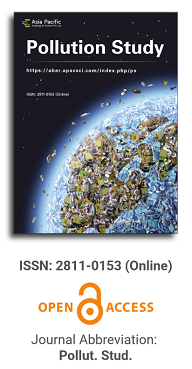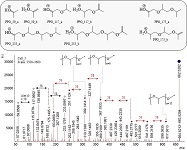
Asia Pacific Academy of Science Pte. Ltd. (APACSCI) specializes in international journal publishing. APACSCI adopts the open access publishing model and provides an important communication bridge for academic groups whose interest fields include engineering, technology, medicine, computer, mathematics, agriculture and forestry, and environment.

The (partial) replacement of synthetic polymers with bioplastics is due to increased production of conventional packaging plastics causing for severe environmental pollution with plastics waste. The bioplastics, however, represent complex mixtures of known and unknown (bio)polymers, fillers, plasticizers, stabilizers, flame retardant, pigments, antioxidants, hydrophobic polymers such as poly(lactic acid), polyethylene, polyesters, glycol, or poly(butylene succinate), and little is known of their chemical safety for both the environment and the human health. Polymerization reactions of bioplastics can produce no intentionally added chemicals to the bulk material, which could be toxic, as well. When polymers are used to food packing, then the latter chemicals could also migrate from the polymer to food. This fact compromises the safety for consumers, as well. The scarce data on chemical safety of bioplastics makes a gap in knowledge of their toxicity to humans and environment. Thus, development of exact analytical protocols for determining chemicals of bioplastics in environmental and food samples as well as packing polymers can only provide warrant for reliable conclusive evidence of their safety for both the human health and the environment. The task is compulsory according to legislation Directives valid to environmental protection, food control, and assessment of the risk to human health. The quantitative and structural determination of analytes is primary research task of analysis of polymers. The methods of mass spectrometry are fruitfully used for these purposes. Methodological development of exact analytical mass spectrometric tools for reliable structural analysis of bioplastics only guarantees their safety, efficacy, and quality to both humans and environment. This study, first, highlights innovative stochastic dynamics equations processing exactly mass spectrometric measurands and, thus, producing exact analyte quantification and 3D molecular and electronic structural analyses. There are determined synthetic polymers such as poly(ethylenglycol), poly(propylene glycol), and polyisoprene as well as biopolymers in bags for foodstuffs made from renewable cellulose and starch, and containing, in total within the 20,416–17,495 chemicals per sample of the composite biopolymers. Advantages of complementary employment in mass spectrometric methods and Fourier transform infrared spectroscopy is highlighted. The study utilizes ultra-high resolution electrospray ionization mass spectrometric and Fourier transform infrared spectroscopic data on biodegradable plastics bags for foodstuffs; high accuracy quantum chemical static methods, molecular dynamics; and chemometrics. There is achieved method performance |r| = 0.99981 determining poly(propylene glycol) in bag for foodstuff containing 20,416 species and using stochastic dynamics mass spectrometric formulas. The results highlight their great capability and applicability to the analytical science as well as relevance to both the fundamental research and to the industry.
Simulation of smoke dispersion and air pollution dynamics
Vol 1, Issue 1, 2020
Download PDF
Abstract
A hybrid model approach is proposed to address the limitations of traditional physical and empirical models in simulating smoke diffusion and depicting gas pollution. This method integrates the semi-Lagrangian method for smoke modeling, with the k-d tree algorithm enhancing computational efficiency. To enhance smoke simulation details, a fluctuating wind field generated by the linear filter method is incorporated into the external force term to refine smoke particle trajectories. The rendering process employs a bidirectional projection function combined with actual smoke textures to mitigate the issue of particle visibility and to significantly enhance the visual fidelity of smoke diffusion. Additionally, an optimized Gaussian plume model is utilized to bridge the gap between physical and empirical models, while a pollution attenuation formula and refined Perlin noise are applied to enrich the global gas pollution details and to increase the realism of pollution dynamics. The method also incorporates an improved time axis algorithm to overcome the issue of static gas pollution color, enabling the depiction of dynamic and gradual pollution changes. Experimental results validate the effectiveness of this approach in generating realistic and dynamic gas pollution scenes in real-time.
Keywords
References
- Stam J. Stable fluids. In: Proceedings of the 26th annual conference on Computer graphics and interactive techniques—SIGGRAPH ’99. pp. 121-128. doi: 10.1145/311535.311548
- Fedkiw R, Stam J, Jensen HW. Visual simulation of smoke. In: Proceedings of the 28th annual conference on Computer graphics and interactive techniques. doi: 10.1145/383259.383260
- Xie Y, Franz E, Chu M, et al. tempoGAN. ACM Transactions on Graphics. 2018; 37(4): 1-15. doi: 10.1145/3197517.3201304
- Tang Y, Wu Y, Lüm Y, et al. Real-time smoke simulation using the improved adaptive vorticity confinement. Journal of Chinese Computer Systems, 2012; 33(12): 2676-2679.
- Tang Y, Sun J, Lüm Y, et al. Real-time simulation algorithm of smoke movement based on arbitrary interactive path. Journal of Chinese Computer Systems. 2016; 37(10): 2334-2337.
- Lu W, Yang HY, Wan Y. Rendering realistic fog using GPU. Journal of Sichuan University (Natural Science Edition). 2015; 52(1): 63-68.
- Guo F, Tang J, Xiao X. Foggy Scene Rendering Based on Transmission Map Estimation. International Journal of Computer Games Technology. 2014; 2014: 1-13. doi: 10.1155/2014/308629
Supporting Agencies
Copyright (c) 2020 Yong Tang, Zhihua Zhen, Xinyu Wang, Xudong Sun

This work is licensed under a Creative Commons Attribution 4.0 International License.

This site is licensed under a Creative Commons Attribution 4.0 International License (CC BY 4.0).
.jpg)
Beijing University of Technology, China



